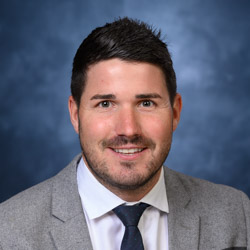Daniel Duffy DVM
Bio
Dan attended veterinary school for 5 years the University of Edinburgh, Scotland where he obtained his veterinary degree with honors becoming a member of the Royal College of Veterinary Surgeons. He then worked with his parents for a short period of time in their small animal mixed practice. He then went on to complete a general rotating medicine and surgery Internship at Colorado State University (CSU). And then went on the complete an intensive 3 year small animal surgery residency and masters of science degree at Purdue University, Indiana.
Dan then spent two years as a clinical assistant professor of orthopedics, soft tissue and neuro surgery at the University of Illinois with a busy surgical (complex trauma) caseload. Dan became a Diplomate of the American College of Veterinary Surgeons (ACVS-SA) and shortly after became a Diplomate of the European College Veterinary Surgeons (ECVS). He also completed further training in education and advanced teaching and a certificate in education becoming a fellow of the Higher Education Academy (FHEA). He was recognized by the Royal College of Veterinary Surgeons (RCVS) and European board of specialization (EBVS) as a recognized specialist in the field of small animal orthopaedic surgery in 2018.
He has authored multiple publications in the area of canine tendon repair techniques and musculoskeletal models.
View my NCBI Bibliography here.
AFFILIATIONS
Member of the Royal College of Veterinary Surgeons
American College of Veterinary Surgeons
European College of Veterinary Surgeons
Member – Veterinary Orthopedic Society
CERTIFICATIONS
Member of the Royal College of Veterinary Surgeons
Diplomate, American College of Veterinary Surgeons – Small Animal
Diplomate, European College of Veterinary Surgeons
Certificate in Higher Education and Fellow of the Higher Education Academy
RCVS Recognized specialist in Small Animal Orthopedics
European Board of Veterinary Recognized Specialist in Small Animal Surgery
Area(s) of Expertise
REGENERATIVE MEDICINE, SPONTANEOUS ANIMAL DISEASE MODELS
Minimally invasive management of joint pathology and intra-articular fractures
Tendon repair, biologics and novel treatment for musculoskeletal disease
Novel suture use for flexor tendon repair
Minimally invasive fracture repair (MIPO)
Translational models for distal extremity tendon repair in people
Total hip replacement
Publications
- Biomechanical evaluation of three adjunctive methods of orthopedic tension band-wire fixation to augment simulated patella tendon repairs in dogs , VETERINARY SURGERY (2023)
- Influence of Kirschner-Wire Insertion Angle on Construct Biomechanics following Tibial Tuberosity Osteotomy Fixation in Dogs , VETERINARY AND COMPARATIVE ORTHOPAEDICS AND TRAUMATOLOGY (2023)
- Influence of three different closure techniques on leakage pressures and leakage location following partial cystectomies in normal dogs , VETERINARY MEDICINE AND SCIENCE (2023)
- Effect of calcanean bone-tunnel orientation for teno-osseous repair in a canine common calcanean tendon avulsion model , VETERINARY SURGERY (2022)
- Effect of epitendinous suture augmentation to a double Krackow suture pattern for canine gastrocnemius tendon repair , AMERICAN JOURNAL OF VETERINARY RESEARCH (2022)
- Ex vivo biomechanical characteristics and effects on gap formation of using an internal fixation plate to augment primary three-loop pulley repair of canine gastrocnemius tendons , AMERICAN JOURNAL OF VETERINARY RESEARCH (2022)
- Influence of barbed suture oversew of the transverse staple line during functional end-to-end stapled anastomosis in a canine jejunal enterectomy model , VETERINARY SURGERY (2022)
- Influence of crotch suture augmentation on leakage pressure and leakage location during functional end-to-end stapled anastomoses in dogs , VETERINARY SURGERY (2022)
- Loop diameter of a modified Kessler locking-loop suture affects in vitro tensile strength and gapping characteristics of canine flexor tendon repairs , AMERICAN JOURNAL OF VETERINARY RESEARCH (2022)
- Loop modification of the traditional three-loop pulley pattern improves the biomechanical properties and resistance to 3-mm gap formation in a canine common calcanean teno-osseous avulsion model , AMERICAN JOURNAL OF VETERINARY RESEARCH (2022)
Grants
Tendon injuries, regardless of the inciting mechanism and predisposing disease process, often require suture tenorrhaphy to allow patients to return to normal function. The goal of surgery is to restore the tendon working length and to prevent elongation. Gap formation at the anastomosis site may significantly delay tendon healing. Gapping >3mm has been shown to prevent progressive increases in tensile strength and stiffness that occurs with normal tendon healing.1 The three-loop pulley (3LP) and locking loop suture patterns are currently standard of care for suture tenorrhaphy in canine patients. In human hand flexor tendon repair, novel tendon suture techniques have demonstrated superiority.2-5 Evaluation of the biomechanical strength of non-traditional suture patterns in an ex-vivo setting is important prior to clinical implementation to assess construct strength and resistance to gap formation, especially for working dogs which experience higher applied loads at the repair site.6 The objective of this study is to compare the biomechanical strength and gapping characteristics of four novel tenorrhaphy patterns compared with a three-loop pulley (3LP) pattern in a canine cadaveric superficial digital flexor tendon (SDFT) model. Our null hypothesis is that there will be no differences in yield, peak and failure loads, and gapping development at the repair site compared to the 3LP pattern. This is an ex-vivo biomechanical experimental study. Sixty cadaveric SDFT units will be tested. Transected SDFT shall be repaired with one of five randomly assigned suture patterns (power analysis, n=12), including 3LP, exposed triple cross-lock continuous, embedded triple cross-lock continuous, triple circle-lock continuous, and modified Tang continuous patterns. Using a high-speed digital camera, failure modes and force at -1 and 3mm gap formation shall be evaluated. Yield, peak, and failure forces shall be measured from load displacement curves using custom software. Significance shall be set at p<0.05.
Groups
- CVM: Clinical Sciences
- CVM
- Clinical Sciences: DOCS Faculty
- Clinical Sciences: DOCS Orthopedics Faculty
- CVM: Focus Area
- CVM: Hospital
- Hospital: Orthopedics
- Research Area of Emphasis: Regenerative Medicine
- CVM: Research Area of Emphasis
- Focus Area: Small Animal Practice
- Research Area of Emphasis: Spontaneous Animal Disease Models
